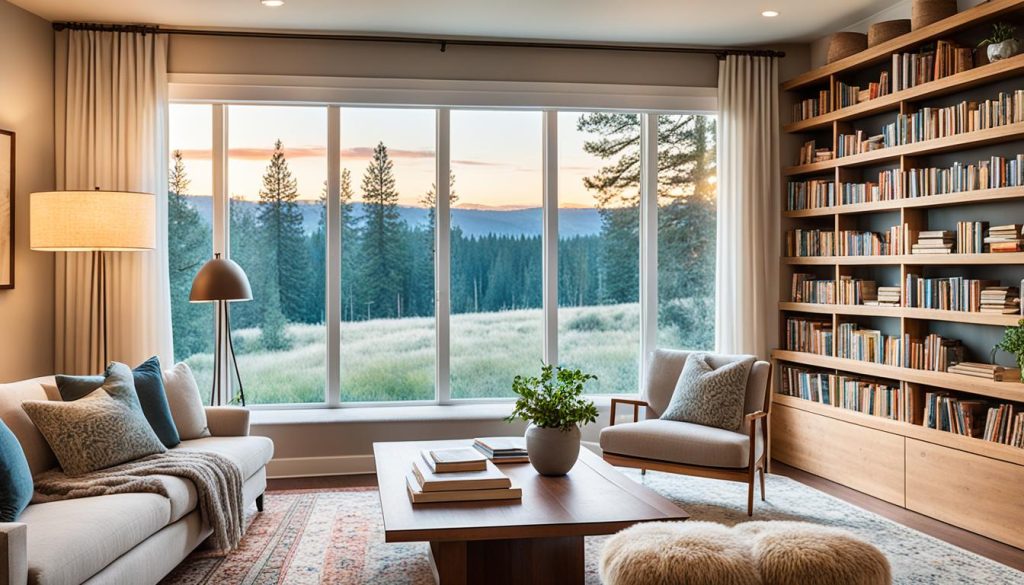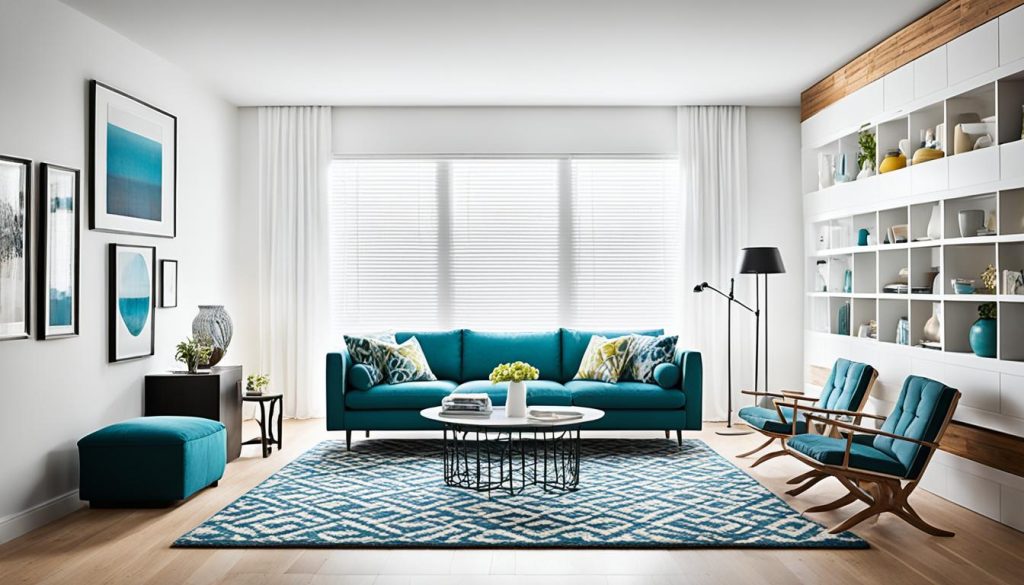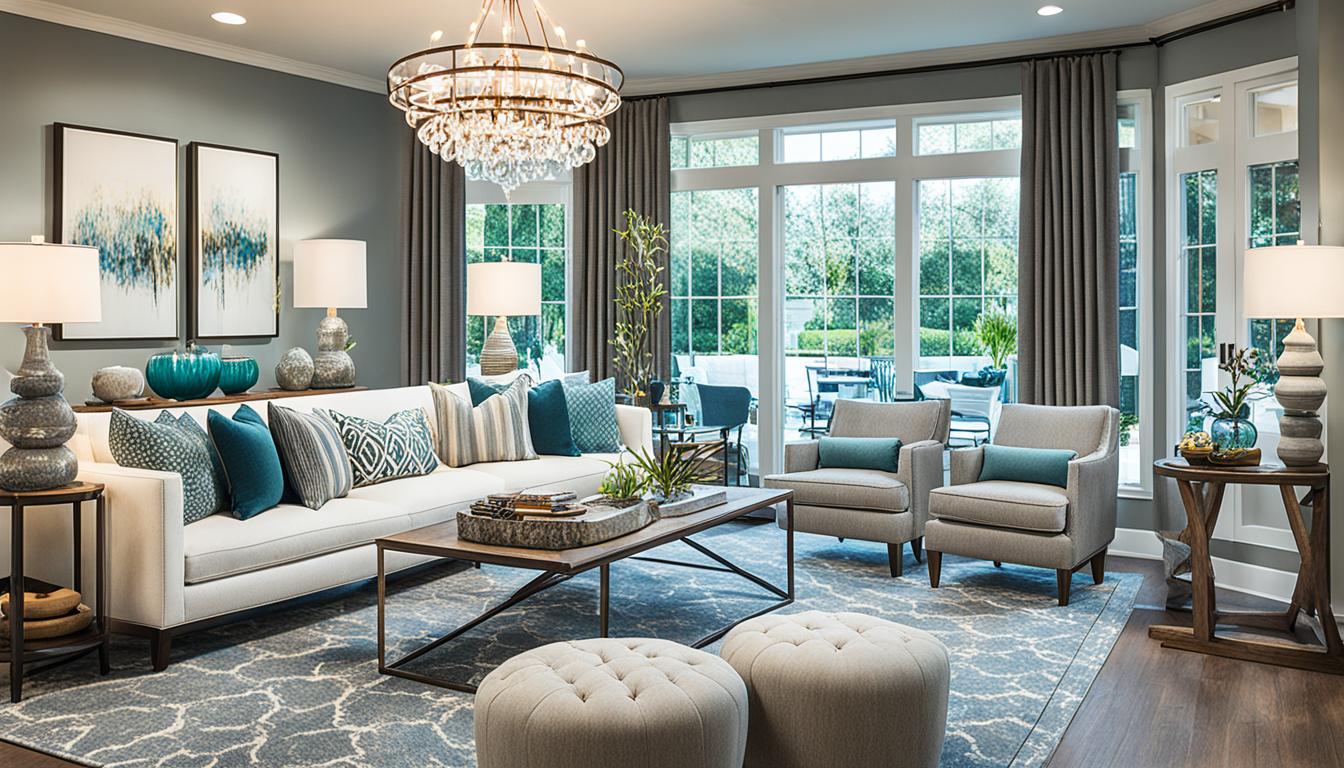Did you know that interior design has a profound impact on our daily lives? It goes beyond just making a space look pretty and involves creating functional, comfortable, and visually appealing environments. From enhancing our moods and productivity to optimizing space utilization, interior design plays a crucial role in transforming any space into a place we love to live, work, and relax in.
Key Takeaways:
- Interior design goes beyond decoration and enhances the aesthetics, functionality, and comfort of a space.
- It involves the careful selection of colors, textures, patterns, and furniture arrangements to create visually pleasing environments.
- Interior design ensures spaces are designed to meet their intended purpose effectively through thoughtful design choices.
- Good interior design promotes comfort through factors like lighting, temperature control, and ergonomic furniture.
- Interior design has a psychological impact on our mood, behavior, and overall well-being, improving our mental health.
Aesthetics
When it comes to interior design, aesthetics play a crucial role in creating visually appealing and captivating spaces. A well-designed interior not only enhances the overall visual appeal but also creates a harmonious and inviting environment. To achieve this, interior designers carefully consider various elements such as colour scheme, textures, patterns, and furniture arrangement.
The selection of appropriate colours is essential as they have the power to evoke different emotions and set the overall mood of a space. Whether you want to create a calm and serene atmosphere or a vibrant and energetic ambiance, the right colour scheme can make all the difference. It’s important to choose colours that complement each other and create a cohesive look.
Textures and patterns add depth and visual interest to a room. By incorporating different textures, such as velvet, silk, or wood, you can create a multi-dimensional and rich environment. Patterns, on the other hand, can make a statement and add personality to a space. From bold geometric prints to delicate floral motifs, the right patterns can transform a room from ordinary to extraordinary.
Furniture arrangement is another crucial aspect of interior design aesthetics. The way furniture is placed in a room greatly impacts the overall look and feel. Whether you prefer a symmetrical layout or a more eclectic mix, the arrangement should be intentional and complement the style and purpose of the space.
Overall, a well-executed interior design plan achieves a harmonious visual experience that aligns with the branding or messaging of a company or individual. By carefully considering the colour scheme, textures, patterns, and furniture arrangement, interior designers create captivating and visually appealing environments that leave a lasting impression.
Functionality
Interior design plays a crucial role in creating spaces that are not only visually appealing but also highly functional. It involves meticulous planning and attention to detail to optimize the layout, furniture placement, and flow of movement within a space.
When it comes to furniture placement, interior designers strategically position pieces to create a harmonious balance between aesthetics and practicality. They consider factors such as the purpose of the room and the needs of its occupants. By placing furniture and fixtures in the right locations, designers ensure efficient use of space while maintaining a pleasing visual appeal.
Another crucial aspect of functionality is the usability of the space. Interior designers incorporate storage solutions, ergonomic furniture, and efficient lighting to enhance usability and efficiency. They carefully consider the needs and preferences of the occupants, creating a space that is user-friendly and accommodates their daily activities.
The flow of movement is also a key consideration in interior design. Designers analyze the natural movement patterns within a space and plan the layout accordingly. A well-designed interior facilitates easy and seamless movement, allowing individuals to navigate through the room with ease.
Efficiency is a fundamental goal of interior design. By optimizing the functionality of a space, designers maximize its potential and create an environment that supports the productivity and well-being of its occupants. Whether it’s a home, office, or any other type of space, interior design ensures that it serves its purpose effectively and efficiently.
Examples of Interior Design Functionality:
- Efficiently utilizing space for storage solutions, such as built-in cabinets or shelving
- Creating designated areas for specific activities, such as a dedicated workspace in a home office
- Optimizing natural light and incorporating efficient lighting fixtures for improved visibility and energy efficiency
- Using ergonomic furniture to promote comfort and reduce strain on the body
- Ensuring adequate space for movement and avoiding clutter or obstacles
Comfort
When it comes to interior design, comfort is an essential consideration. Creating a space that is not only visually appealing but also comfortable is crucial for the overall well-being of its occupants. There are several factors that contribute to the comfort of a living or working environment.
1. Lighting: Adequate lighting levels play a significant role in creating a comfortable atmosphere. Well-lit spaces not only enhance visibility but also contribute to a sense of warmth and coziness. Natural light is particularly beneficial, as it promotes a connection with the outdoors and provides a sense of openness. Incorporating a variety of lighting fixtures, such as task lighting and ambient lighting, allows for flexibility and enhances the overall comfort of the space.
2. Temperature Control: Maintaining a comfortable temperature is essential for creating a pleasant environment. Whether it’s ensuring the right level of warmth during the cold winter months or implementing cooling strategies in hot summers, temperature control is pivotal in promoting comfort. Proper insulation, efficient HVAC systems, and the use of smart technologies can help regulate the temperature and create an optimal indoor climate.
3. Acoustics: Noise levels can significantly affect the comfort of a space. Excessive noise can cause distractions and hinder concentration, leading to stress and discomfort. By incorporating sound-absorbing materials, such as acoustic panels and carpets, interior designers can create a quieter and more peaceful environment. Strategic layout planning and the use of noise-reducing techniques contribute to better acoustics, ensuring a comfortable and serene atmosphere.
4. Ergonomic Furniture: The choice of furniture is crucial in promoting comfort and preventing discomfort or musculoskeletal issues. Ergonomic furniture is designed to provide optimal support and promote healthy postures. Features such as adjustable chairs, ergonomic desks, and supportive cushions contribute to the well-being of individuals, reducing fatigue and promoting productivity.
Interior designers understand the significance of these factors and incorporate them into their designs to ensure a comfortable experience for the occupants of a space. By creating environments that prioritize comfort, interior design enhances the overall satisfaction and well-being of individuals.

| Comfort Factors | Importance |
|---|---|
| Lighting | Creates a warm and inviting atmosphere |
| Temperature Control | Regulates the indoor climate for optimal comfort |
| Acoustics | Reduces noise levels and promotes a peaceful environment |
| Ergonomic Furniture | Supports healthy postures and prevents discomfort |
Psychological Impact
Interior design has a profound impact on our mood, behavior, and overall mental well-being. It goes beyond creating visually pleasing spaces and extends into the realm of psychology. When thoughtfully designed, interiors have the power to promote relaxation, enhance productivity, stimulate creativity, and foster social interaction.
Color psychology is a key element in interior design that influences our emotional state. Warm colors like reds and oranges can evoke energy and passion, while cool colors like blues and greens can create a sense of calm and tranquility. By carefully selecting and applying colors, interior designers can elicit desired emotional responses and set the overall mood of a space.
Lighting is another crucial factor in interior design that impacts our mental health and well-being. Natural lighting can improve our mood, increase productivity, and regulate our sleep-wake cycle. On the other hand, harsh or dim lighting can cause eye strain, affect our concentration, and lead to feelings of fatigue. By incorporating appropriate lighting techniques, such as task lighting and ambient lighting, interior designers create spaces that optimize our mental and visual comfort.
Space planning is an essential aspect of interior design that influences our behavior and functional usage of a space. A well-planned layout can encourage movement and flow, making it easier for individuals to navigate through a room. It also ensures that the arrangement of furniture and fixtures promotes efficient usability. Whether it’s an open concept kitchen that encourages social interaction or a home office designed for optimal productivity, the intentional placement of elements shapes our behavior within a space.
Moreover, interior design has a personal impact on individuals, allowing them to feel more connected and at ease in their surroundings. By incorporating elements that resonate with their interests, values, and style preferences, interiors become an extension of their identity. This sense of belonging and connection positively influences mental well-being and overall satisfaction.

A Well-Designed Interior Can:
- Create a relaxing environment that reduces stress and anxiety.
- Improve focus and concentration for enhanced productivity.
- Foster creativity and inspiration.
- Encourage social interaction and meaningful connections.
- Promote a sense of well-being and improve mental health.
The Role of Interior Design in Productivity:
A well-designed interior can significantly impact our productivity levels. By optimizing the layout, incorporating ergonomic furniture, and providing adequate lighting, interior designers create workspaces that promote focus and efficiency. The design of an office, for example, can have a direct influence on employee motivation and job satisfaction, ultimately leading to increased productivity and performance. Understanding the psychology behind interior design allows us to harness its potential to optimize our mental well-being and enhance our daily experiences.
Space Optimization
When it comes to interior design, one of the most important considerations is space optimization. Efficiently utilizing available space and determining the best use of the area are key factors that interior designers take into account. By carefully analyzing the dimensions and layout of a room, designers can come up with creative solutions that maximize both functionality and aesthetic appeal.
During the design process, interior designers consider various factors to optimize space utilization. Storage needs, traffic flow, and specific activities that will take place in the area are all taken into account. By incorporating smart storage solutions, making use of vertical space, and employing clever design techniques, designers can maximize the potential of any given space.
Space optimization is essential for creating harmonious and functional interiors. It allows for efficient storage and organization, improves traffic flow, and enhances the overall functionality of a space. By maximizing every square inch, designers ensure that the area is utilized to its fullest potential, resulting in a space that is not only visually appealing but also practical and efficient.
Benefits of Space Optimization
Space optimization offers numerous benefits, including:
- Maximizing the functionality of a space by using it to its full potential
- Creating efficient storage solutions to keep the area organized and clutter-free
- Improving traffic flow and ease of movement within the space
- Enhancing the overall aesthetic appeal of the room by carefully arranging furniture and decor
| Benefits of Space Optimization | Examples |
|---|---|
| Maximizing functionality | Creating built-in bookshelves in a small living room to maximize storage and display space |
| Efficient storage solutions | Designing custom cabinets and drawers in a kitchen to maximize storage capacity |
| Improved traffic flow | Arranging furniture in a way that allows for easy movement and clear pathways |
| Enhanced aesthetic appeal | Using vertical space to hang artwork and create visual interest |
By optimizing space, interior designers can transform even the smallest areas into functional and visually pleasing spaces. Whether it’s a cozy bedroom, a compact kitchen, or a multi-purpose living area, efficient utilization of space is key to achieving the best use of the area.
Value of Interior Design
Interior design is an invaluable investment that brings tremendous value to our living spaces. It goes beyond mere aesthetics and encompasses the perfect blend of functionality, comfort, and psychological impact. Through thoughtful and intentional design choices, interior designers create visually pleasing environments that truly enhance our daily experiences.
Aesthetics play a significant role in interior design, as spaces are transformed into visually appealing havens. The careful selection of color schemes, textures, patterns, and furniture arrangements creates a harmonious visual experience that uplifts and inspires. By creating a visually pleasing atmosphere, interior design speaks to our senses and allows us to feel at ease in our surroundings.
Functionality is another key aspect of interior design that adds value to our living spaces. By optimizing furniture placement, flow of movement, and usability, interior designers ensure that spaces are designed to meet their intended purpose effectively. With the incorporation of storage solutions, ergonomic furniture, and efficient lighting, interior design enhances the practicality and efficiency of a space. This not only maximizes the usability but also contributes to our overall well-being and productivity.
One cannot underestimate the psychological impact of interior design. It has the power to influence our mood, behavior, and mental well-being. Through the use of appropriate lighting, color psychology, and space planning, interior designers create spaces that promote relaxation, productivity, and creativity. By prioritizing comfort and creating environments that cater to our specific needs, interior design aids in reducing stress, enhancing focus, and improving our overall satisfaction with our living spaces.
Space optimization is yet another essential aspect of interior design. With the efficient utilization of available space, interior designers maximize the potential of any given area. By analyzing dimensions, traffic flow, and specific activities, they create designs that make the most of the space. This ensures that every inch is utilized effectively and contributes to the overall functionality and beauty of the interior.
In conclusion, interior design brings immense value to our living spaces. Its ability to enhance aesthetics, functionality, comfort, psychological impact, and space optimization results in spaces that truly elevate our quality of life. Investing in professional interior design not only creates visually pleasing environments but also improves our overall well-being, making it an essential component of any space transformation.
